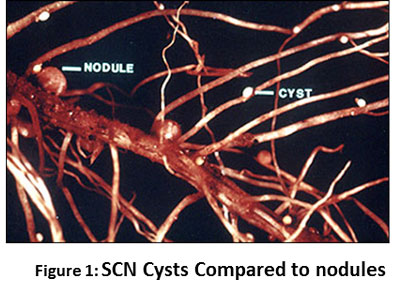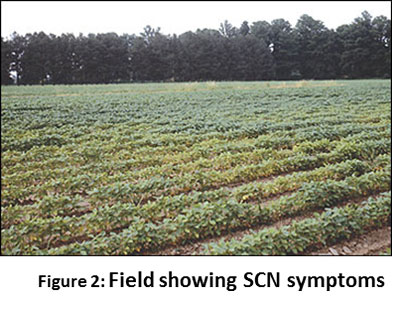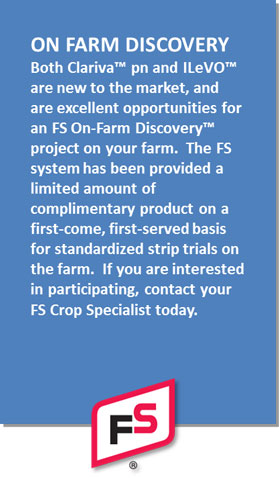
- SCN remains the most significant yield-robbing pathogen in soybeans
- SCN needs to be managed with good decisions BEFORE planting
- SCN population monitoring is the foundation of the management system
- Crop rotation and resistant varieties are two key cultural management tools
- Clariva™ pn and ILeVO™ are new crop protection tools for managing SCN
- Farmer’s opportunity for FS On Farm Discovery™ trial of tools
Soybean cyst nemadode (SCN), officially HSeterodera glycines, is the most economically significant pathogen of soybeans in the United States, accounting for an estimated 48 million bushels of yield loss
annually. SCN is a microscopic roundworm that was first discovered in the US in 1954 and is now present throughout the major soybean growing regions of the US and the world.

The second stage juvenile infects the root, penetrates to the xylem, and establishes a feeding site, siphoning off plant nutrients for its own growth and reproduction. The females are about 1mm in length, lemon shaped, and noticeably smaller than Bradyrhizobium nodules (Figure 1). The female deposits 200-400 eggs in a sac, then dies, and her body forms a cyst, which can survive in the soil for many years and through harsh conditions. When environmental conditions are optimal for soybean growth, the eggs hatch and the life cycle is repeated.
SCN can reduce yield in an individual field by 40% or more, reducing nutrients available to the plant as well as restricting root growth and suppressing nodulation. SCN feeding injury also provides a point of entry for other plant pathogens to infect the root system, most notably Sudden Death Syndrome (SDS). While the two pathogens are not interdependent, SDS symptoms are often more severe when associated with SCN infestation. Above-ground plant symptoms with SCN are non-distinct from other many environmental causes and typically involve patchy areas of stunted plants with some mild yellowing of leaves (Figure 2). Later in the season, these areas of the field may become noticeably chlorotic and senesce early, which can be readily observed via aerial photography using a UAV.
SCN cannot be eradicated and must be managed using a systems approach, which is focused on keeping populations at manageable levels. The foundation of your SCN management program should be a routine sampling and scouting program to understand population dynamics. SCN can become established in a field and cause significant yield reductions before any above-ground symptoms appear in the plants and routine sampling is the only way to achieve early detection and trigger SCN population management strategies. Distribution of SCN is patchy within a field and populations vary by season, which makes sampling a challenge. Please see the provided references below for guidance on good sampling technique.
Management of SCN must be done mostly BEFORE planting. Management systems employ a combination of good cultural practices, such as crop rotation, avoiding additive stressors, controlling winter annual weeds, and selecting resistant soybean varieties. Crop rotation to non-host species again works to keep populations at manageable levels by disrupting the reproductive cycle. Because cysts can survive for many years in soil, rotation alone is not an effective strategy. Any practice geared toward establishing and sustaining good plant health (e.g. maintaining fertility, avoiding compaction, controlling weeds and insects, possibly foliar fungicides) will help the plant fend off yield losses due to SCN. Most commercially available soybeans have been selected for naturally occurring genetic resistance to SCN, but the vast majority is from a single genetic source, PI88788. SCN is gradually evolving around this mechanism, so soybean breeders are increasingly turning to alternative genetic sources to keep ahead of the problem. When SCN is an issue, always make sure that you are planting a variety that is highly rated for SCN resistance. In growing environments with high SCN population pressure or resistant races, resistant varieties alone may not provide adequate control.

Fortunately, we now also have some new crop protection alternatives for SCN management. Clariva™ pn is a new biological seed treatment product introduced by Syngenta in 2014. The active ingredient is Pasteuria nishizawae, which is a bacterium that infects the nematode and provides a biological method of control. University and on-farm trials in 2014 across the Midwest showed a range of yield responses, but the most consistent and value-added response was in situations with high SCN pressure and high yield potential. Again, knowing your SCN populations in your fields will help you position the product where it most likely to provide return on investment. Another new alternative for 2015 is ILeVO from Bayer CropSciences, which uses the fungicide active ingredient fluopyram to very effectively target SDS. This chemistry also has the supplemental benefit of nematicidal activity for up to 30 days in the soil surrounding the root, possibly Preventing the root feeding point of entry for SDS in the critical early development period of the soybean.
Clariva is a trademark of Syngenta. ILeVO is a trademark of Bayer CropSciences. On Farm Discovery™ is a trademark of GROWMARK Inc. Photos used with permission of University of Missouri.